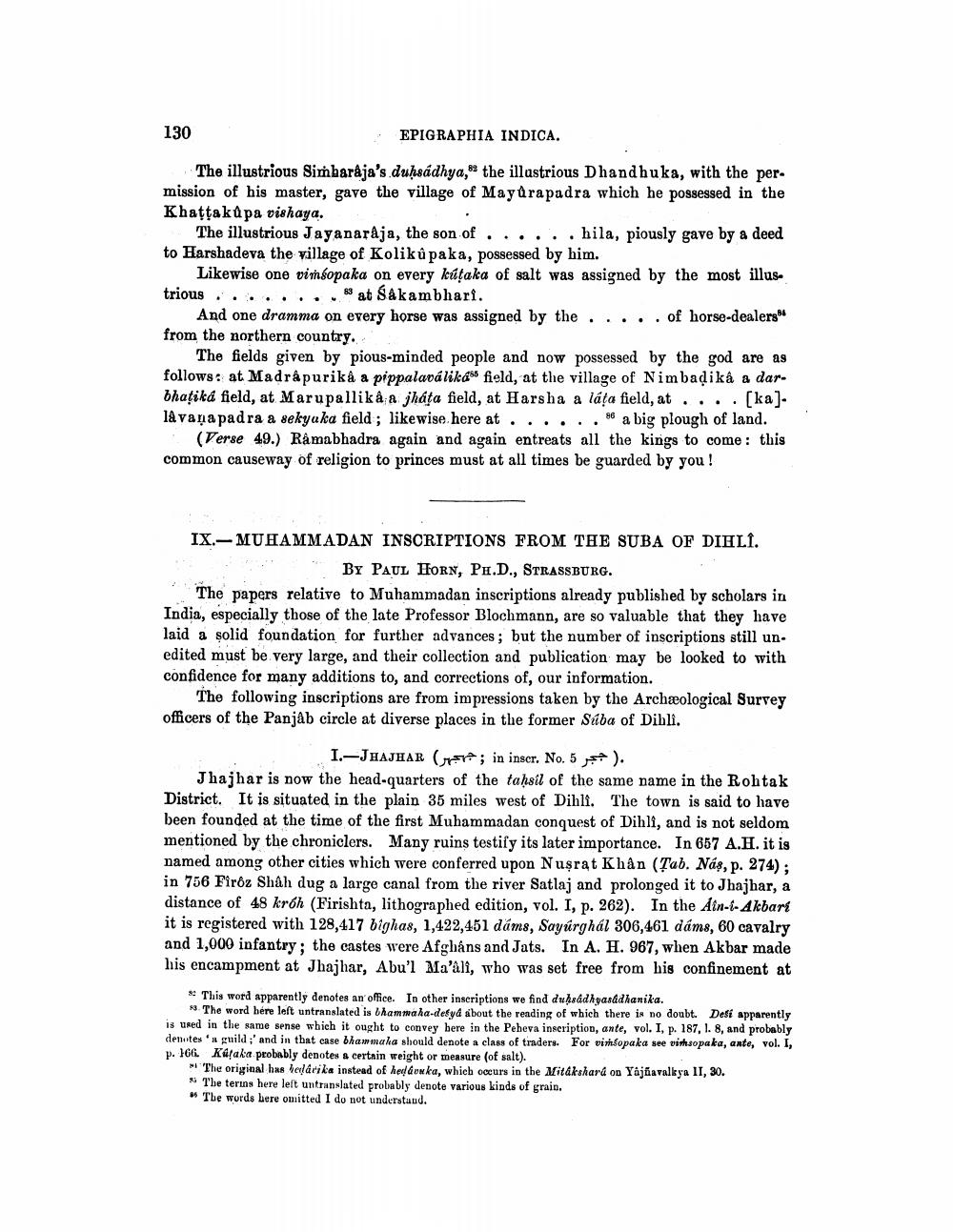________________
130
EPIGRAPHIA INDICA.
The illustrious Simbaraja's duhsádhya, the illustrious Dhandhuka, with the permission of his master, gave the village of Mayurapadra which he possessed in the Khattakúpa vishaya.
The illustrious Jayanaraja, the son of ......hila, piously gave by a deed to Harshadeva the village of Kolikû paka, possessed by him.
Likewise one vimeopaka on every kutaka of salt was assigned by the most illustrious........ 83 at Sakambhari.
And one dramma on every horse was assigned by the ..... of horse-dealers" from the northern country.
The fields given by pious-minded people and now possessed by the god are as follows: at Madråpurikà a pippalaválikáss field, at the village of Nimbadika a darbhatiká field, at Marupallikà a jhata field, at Harsha a láța field, at.... [ka). la vanapadra a sekyaka field; likewise here at ...... a big plough of land.
(Verse 49.) Râmnbhadra again and again entreats all the kings to come: this common causeway of religion to princes must at all times be guarded by you !
IX.-MUHAMMADAN INSCRIPTIONS FROM THE SUBA OF DIHLI.
" " BY PAUL HORN, PH.D., STRASSBURG. The papers relative to Muhammadan inscriptions already published by scholars in India, especially those of the late Professor Blochmann, are so valuable that they have laid a solid foundation for further advances; but the number of inscriptions still un. edited must be very large, and their collection and publication may be looked to with confidence for many additions to, and corrections of, our information.
The following inscriptions are from impressions taken by the Archæological Survey officers of the Panjab circle at diverse places in the former Saba of Dibli.
I.-JHAJHAR Grave; in inser. No. 5 ). Jhajhar is now the head-quarters of the tahsil of the same name in the Rohtak District. It is situated in the plain 35 miles west of Dihli. The town is said to have been founded at the time of the first Muhammadan conquest of Dihli, and is not seldom mentioned by the chroniclers. Many ruins testify its later importance. In 657 A.H. it is named among other cities which were conferred upon Nusrat Khan (Tab. Nás, p. 274); in 756 Firoz Shah dug a large canal from the river Satlaj and prolonged it to Jhajhar, a distance of 48 kr 6h (Firishta, lithographed edition, vol. I, p. 262). In the Ain-l-Akbari it is registered with 128,417 bighas, 1,422,451 dáms, Sayúrghal 306,461 dáms, 60 cavalry and 1,000 infantry: the castes were Afgháns and Jats. In A. H. 967, when Akbar made his encampment at Jhajhar, Abu'l Ma'ali, who was set free from his confinement at
* This word apparently denotes an office. In other inscriptions we find dubsadhyarddhanika.
The word bere left untranslated is bham waha-defyd about the reading of which there is no doubt. Desi apparently is used in the same sense which it ought to convey here in the Peheva inseription, ante, vol. I, p. 187, 1. 8, and probably denotes guild,' and in that case bhammala should denote a class of traders. For vishfopaka see virhaopaka, ante, vol. I, p. 166. Kdaka probably denotes a certain weight or measure (of salt).
The original han belarika instead of had donka, which occurs in the Mitakshard on Yajfavalkya 11, 30. $ The terins here left untranslated probably denote various kinds of grain. # Tbe words bere omitted I do not understand.




